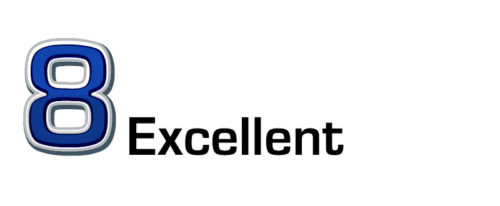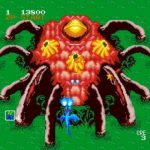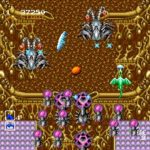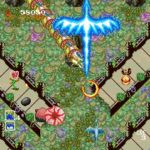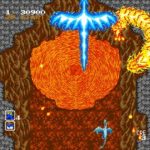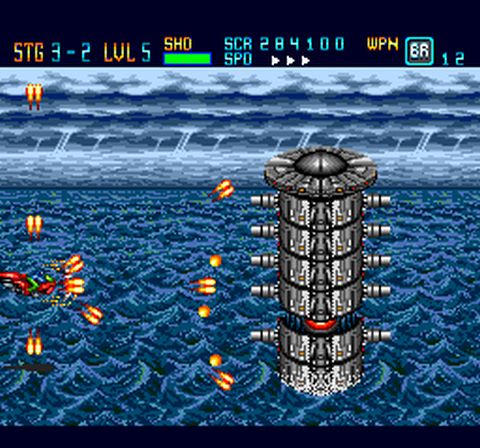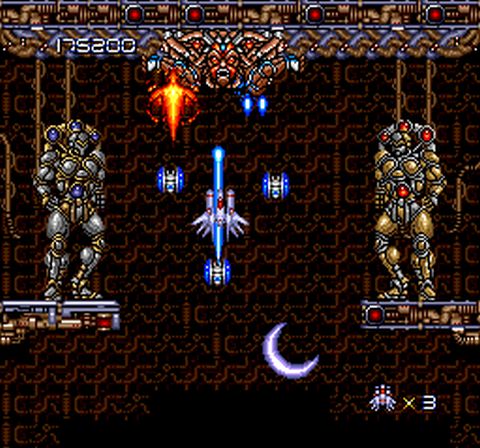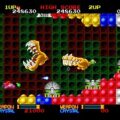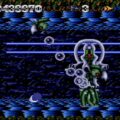Developer: Namco Publisher: Namco Released: 1991 Genre: Shooter
My love of Dragon Spirit is a bit strange, I will admit. Its not that it isn’t a good game, because it is. But I think I really appreciate it because it is one of the few shooters I completed in the arcade. The NES version with its additional content gave me more but wasn’t a true sequel. I saw Dragon Saber in magazines but sadly never in a local arcade and hoped for a console port. That never came, at least in the US. Little did I know the PC Engine received an excellent conversion of this great arcade game and one of its strongest shooters.
One could easily assume that Dragon Saber is identical to the first game. The UI is the same, the graphics look similar, and even the first level in both games are thematically alike. The devil is in the details however. As a baseline you can now take three hits before death. The first game was brutal in this regard so every little bit helps. The biggest addition is a charged shot. When you are not firing it charges automatically and produces different effects depending on the weapon. Its quick but still a risk and incorporating it into gameplay adds an element of strategy.
The massive number of power-ups from the original has been paired down slightly. Make no mistake, the list is still pretty long. There are seven primary power-ups with most returning from the first game. New to this title are the thunder dragon and green dragon, which spits flames at an angle. The main difference now is that most weapons show up in nearly every level at least once. Most of the time certain dragon forms appear when they are the most useful such as at the beginning of stage three. But some are so overpowered it is tempting to avoid switching. The orange dragon’s power shot is a massive flame dragon that covers most of the screen. And you can spam it continuously!
The dragon spirit games have always moved at a deliberate pace compared to other shooters. That does not make them any less intense. Prioritizing ground and air targets is what gives these games their flavor. Your weapons speed is slower than the arcade making it tougher to clear the screen faster. It is easy to become overwhelmed as a result but it never feels cheap. Like its predecessor Dragon Saber has nine levels. The pacing of the levels is a bit odd. Some like stage five are incredibly short. Others like the ice caverns of stage six or stage three drag on longer than I would like. I wish it were more consistent, but this is a small complaint.
While there have been quality of life improvements the difficulty still remains high. Even with an extra hit you are still going to die and end up at a prior checkpoint frequently. To its credit power-ups appear regularly but this is still rough. Bullets blend into the background and the game is stingy with hearts. Two-player coop helps significantly, not just because of the increased firepower but because you still progress so long as one player is still alive. I am an anti-social gamer so that wasn’t an option.
Dragon Saber looked fantastic in the arcade and is still amazing today. Sadly, most of that visual luster is lost. The biggest loss is the removal of all of the scrolling backgrounds. In the arcade the illusion of depth they added was incredible. Stage four was beautiful but on the PC Engine every level it is dull and lifeless in comparison. Some of the more impressive special effects are missing, most notably scaling. The scaling enemy sprites are still here but they look cheap in comparison. The last hit comes to the massive screen filling bosses. Their designs are the same however the difference in resolution makes them smaller and less threatening.
Not to harp on the game too much as it still looks good. The game’s art direction is still fantastic. The basic early levels give way to fantastical architecture later that are dripping with detail. It gets a little bit weird when gun turrets and other modern-day weapons show up in a fantasy shooter but whatever, I ain’t complaining. The PC Engine manages to capture the broad strokes but loses out on the smaller details. While alright I would have loved to have seen this on the SNES or Genesis.
In Closing
Dragon Saber does not add much to the formula because it didn’t need to. This is an excellent sequel and game and one of my favorite shooters on the system. Dragon Saber also hasn’t been re-released much, making this port a viable way to still experience this great game.
